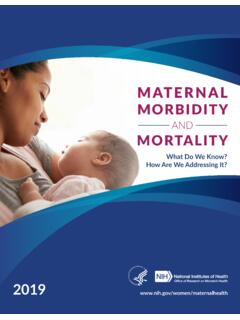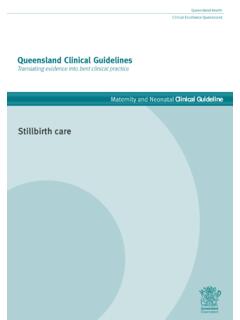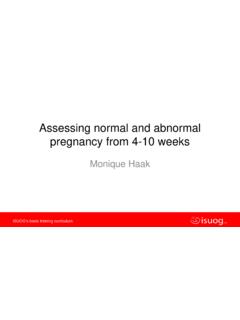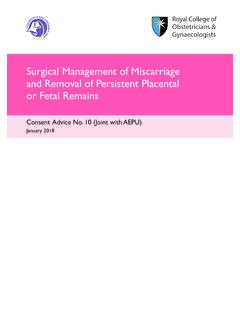Transcription of Polycystic Ovary/Ovarian Syndrome (PCOS)
1 Ovary/Ovarian Syndrome (PCOS) Underrecognized, Underdiagnosed, and Understudied Acknowledgments This informational booklet was developed as part of Lt. Col. Dr. Kim Hopkins postdoctoral training with Dr. Samia Noursi at ORWH. Many thanks to special volunteers Nathan Dinh (University of Richmond) and Bani Saluja (University of Maryland), who played a major role in compiling the information in this booklet. Table of Contents Section I: What is PCOS? ..1 Section II: Defining PCOS through the years ..2 Section III: Signs of PCOS ..3 Section IV: Risk factors and preventive measures.
2 6 Section V: Further information for health care providers and researchers ..8 Section VI: Economic impact ..9 Section VII: How NIH is addressing PCOS ..10 Section VIII: Conclusion ..11 Section IX: Definitions ..12 References ..13iiSection I: What is PCOS? Polycystic Ovary/Ovarian Syndrome (PCOS) is a set of symptoms related to an imbalance of hormones that can affect women and girls of reproductive 7 It is defined and diagnosed by a combination of signs and symptoms of androgen excess, ovarian dysfunction, and Polycystic ovarian morphology on This informational booklet provides guidance for those who are concerned that they may have PCOS and those who have already been diagnosed.
3 There is also information on current efforts to understand and treat PCOS. Polycystic Ovary/Ovarian Syndrome : Underrecognized, Underdiagnosed, and Understudied * Tomlinson, J. A., Pinkney, J. H., Evans, P., Millward, A., & Stenhouse, E. (2013). Screening for diabetes and cardiometabolic disease in women with Polycystic ovary Syndrome . The British Journal of Diabetes & Vascular Disease, 13(3), 115 123. least 70% of women with PCOS remain undiagnosed in primary care* 1 Section II: Defining PCOS through the years To better understand what PCOS is, it is important to know how PCOS is defined and categorized.
4 Although it is called Polycystic Ovary/Ovarian Syndrome , PCOS is not primarily defined by ovarian Rather, PCOS is defined by the presence of at least two of three diagnostic criteria. These diagnostic criteria have been defined three separate times by the National Institutes of Health (NIH) in 1990, by the European Society of Human Reproduction and Embryology (ESHRE) and the American Society for Reproductive Medicine (ASRM) in 2003 (also known as the Rotterdam criteria), and by the Androgen Excess and PCOS Society (AE-PCOS) in 2006. In 2012, NIH endorsed the 2003 Rotterdam criteria for PCOS.
5 See the various definitions below: Criteria NIH 1990 ESHRE/ASRM (Rotterdam) 2003AE-PCOS 2006 NIH 2012 acceptance of Rotterdam 2003 Hyperandrogenism Ovarian dysfunction Polycystic ovarian morphology 2 of 2 required2 of 3 required2 of 3 required2 of 3 required Exclusion of conditions that mimic PCOS Specific disorders with signs and symptoms that overlap with those of PCOS must be ruled out for an accurate PCOS diagnosis. These include hyperprolactinemia, non-classic congenital adrenal hyperplasia, and Cushing s Syndrome . Because of the diagnostic challenges involved with PCOS, primary care providers might recommend seeing a gynecologist, which is a doctor who specializes in the health of a woman s reproductive system, an endocrinologist, which is a doctor who specializes in hormones, or a reproductive endocrinologist, which is a doctor who specializes in a woman s reproductive system, hormones, and disorders may vary, from complete absence of menstruation (amenorrhea) to menstruation delayed to 35 days or more (oligomenorrhea) to heavy bleeding (menorrhagia)
6 Women with irregular menstrual periods have a 91% chance of having Those with PCOS are 15 times more likely to report Menstrual Disorders High levels of androgens typically lead to various dermatological ,10 These include hirsutism (coarse and dark hair on the body areas where men typically grow hair , the face, abdomen, chest, and back), acne, and balding/alopecia. In adolescents, some of the dermatological symptoms may be caused by puberty rather than PCOS. Skin discoloration (acanthosis nigricans) HirsutismBaldingAcne Oily skinDermatological Features Section III: Signs of PCOS 3 PCOS Affects Many Areas of a Woman s Life a.
7 Health implications Dermatological hirsutism, acne Metabolic obesity, metabolic Syndrome , insulin resistance, type 2 diabetes Psychological anxiety, depression Reproductive infertility, preeclampsia, miscarriageSleep disordered sleep, sleep apnea Excessive follicles, which is defined as 25 or more follicles that are 2 mm to 10 mm in a single view of a transvaginal ultrasound , may be present in PCOS. Additionally, increased ovarian volume, an ovary that is more than 10 mL, may be present. Enlarged ovaryExcessive follicles (magnified) Polycystic Ovaries Normal ovaryUterus4 Adolescence Diagnosing PCOS in adolescents is difficult because PCOS and puberty have similar features.
8 These include irregular menstrual cycles and acne. For an accurate diagnosis, adolescents should have all three elements of the Rotterdam criteria for PCOS. Hyperandrogenemia is the main marker for PCOS in Oligomenorrhea or amenorrhea should be present for at least 2 years after the first period. Forty percent of adolescents with menstrual irregularity have Polycystic ovaries. Reproductive age Fertility issues and hirsutism are the primary issues for women at reproductive ages. Infertility is caused by high levels of androgen and luteinizing hormones, which can lead to irregular menstrual cycles and anovulation, which is an absence of ovulation during a menstrual Women with PCOS have three to four times the rate of pregnancy-induced hypertension and There is also a significantly increased risk of endometrial cancer in women with Late reproductive to menopausal age In addition to endometrial cancer, women over 54 years of age with PCOS were found to have a significant risk of ovarian cancer.
9 Though the risk for breast cancer is not significantly increased by having Older women with PCOS have a fourfold to sixfold increase of diabetes compared with women without Older women with PCOS also have more severe hirsutism, in addition to an increased number of metabolic and cardiovascular risk An international disease in many forms Between 5% and 26% of women are affected by PCOS, depending on the diagnostic criteria ,13 Women throughout the lifespan are at risk of being affected by PCOS, and women from all regions of the world including Australia,14 China,15 Denmark,16 Greece,17 India,18 the Netherlands,19 Spain,4 the United Kingdom,20 and the have reported cases of PCOS.
10 There are conflicting results concerning differences in PCOS rates by race, but severity and expression of symptoms may vary based on environmental ,22 Understanding differences in symptoms among different racial and ethnic groups can help with the diagnosis: Relatively mild in White women Higher body mass index (BMI) in White women, especially in North America and Australia More severe hirsutism in Middle Eastern, Hispanic, and Mediterranean women Increased central adiposity, insulin resistance, diabetes, metabolic risks, and acanthosis nigricans (dark discoloration in body folds and creases)





